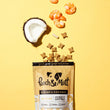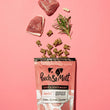FREE UK DELIVERY ON ORDERS OVER £39.99
When bringing home your puppy, you’re often sent home not just with your furry little bundle of joy - but also a sample bag of the food they’ve been eating whilst with their littermates.
While the option to keep them on this food is entirely up to you, it may be that after your own research you’d prefer to feed them something else. Or, it may be that you’ve found their current food doesn’t seem to be agreeing with their sensitive puppy tummy.
So, how do you go about safely and effectively transitioning your puppy to a new diet? We pooch experts are here to take you through a day-by-day guide on how you can go about gradually changing your puppy's food - avoiding any of the unwanted side effects, and making for one happy and satisfied pup!
There are a few reasons why you might want to switch up your puppy’s diet once they’re home - whether it’s personal preference or concerns with your pup’s overall digestive health.
These could be:
As well as personal preference and knowing what’s best for your puppy, you may find that your pup’s overall health and digestive function is telling you it’s time to try something new.
Consider changing your puppy’s food if you find them displaying the following symptoms:
You may have heard from other experts, vets and puppy owners that it’s always advised to gradually transition your puppy from one type of food to another.
This is due to the sensitive nature of puppy tummies.
Along with the rest of their body, when your puppy comes home, their tummy is still developing and gaining all the good bacteria it needs to stay strong. That said, puppy tummies can easily be knocked out of balance and any food or drastic change in diet should always be approached gradually, to avoid an upset tummy.
Due to the sensitive nature of pup tums, switching their puppy food without doing so gradually can lead to digestive and gastrointestinal issues. The drastic change in ingredients and diet agitates their developing digestive system, meaning any food changes should always be approached with caution.
If you suddenly change your puppy’s diet, you may find they experience symptoms such as:
Transitioning your puppy’s diet takes time, care and attention - but it's the best way to cater for developing tummies.
When gradually switching over their food, weighing it out or using measurement tools like a cup or dog food scoop is a good idea. This way, you’re certain that you’re accurately making a gradual switch and they’re getting all the food they need.
Along with those handy tools, use the following day-by-day guide to safely and efficiently switch up your puppy’s food.

Measure out their regular food, removing at least a quarter of the portion. Replace this with their new food. Monitor their reaction to the new food and keep a close eye on them and their poops, to see whether the change has had any side effects.
If your puppy seems happy and hasn’t shown any negative reaction, you can go ahead and split their regular food and new food 50/50. Measure out half a portion of their regular food, and replace the other half with their new food. Continue to keep a close eye on your puppy after feeding, to spot any reactions or side effects.
If your pup still seems happy and healthy after each meal, you can move onto feeding them a portion of food that’s made up of ¾ of their new food, and ¼ of their old food. Continue to monitor your puppy and their poops post feeding time.
The last few days: Day 10-14
Once you’ve had a good couple of days serving them mostly the new food, you can fully transition them onto their new diet. Continue to keep a close eye in the first few weeks on their new food, and always reach out to your vet if they begin showing signs of digestive issues like vomiting or diarrhoea.
The whole puppy food transition process takes place in under two weeks, where they should then be fully adjusted to their new food.
You may find your pup is getting on well with their new food within the week, but it’s important to see the whole transition through to avoid any upset tummies.
Puppies with digestive or gastrointestinal issues may take longer to adjust. If symptoms like looser stools or vomiting persist after three weeks, be sure to contact your vet for further support or guidance.
If you discover early on that your pup has long-term digestive or gastro issues, and you’re wondering what their diet will look like as they grow older - don’t worry!
Here at Pooch & Mutt, we cater to every kind of dog, especially those whose diet needs a little extra love and attention. For dogs with allergies, check out our grain-free, vet-developed Sensitivity Dry Dog Food for Allergies. Or for those prone to an iffy tummy, try out our Health & Digestion Dry Food or our vet-developed Gastrointestinal Dry Dog Food.
Better yet, add some functional goodness to their din-dins with our Bionic Biotic powered supplement, specially formulated with antioxidants, probiotics, fish oil and vitamins and minerals that can help with upset tummies (suitable for dogs and puppies over 12 weeks old!).
The time in which you transition your puppy to adult food will differ between breeds as it’s based on growth, maturity and weight.
By rule of thumb, puppies are ready for adult food when they’ve reached 80% of their final body weight and they’ve done the majority of their growing.
When your pup first comes home, it’s advised to feed them smaller portions, in accordance with their size and weight, a maximum of four times a day.
It’s advised that you do this until they’re around 6 months old when the portions can be a little bigger, and reduced to twice daily.
If a puppy accidentally consumes adult dog food, there’s no need to worry - it’s completely harmless! It’s just not recommended to feed it to them regularly.
This is because puppies need a certain amount of nutrients and have different dietary requirements to adult dogs, so their food needs to reflect this.
Puppies can often start eating adult food regularly after 12 months, but this also depends on breed, size and weight.
No matter how strategic you are with their diet switch, your pup still may experience some diarrhoea due to their overly sensitive tummies. That said, if all things are well, this should settle after a couple of days.
If diarrhoea persists and/or is paired with vomiting and any other concerning symptoms, be sure to contact your vet for further support and advice.
Never miss a treat!
Subscribe to our newsletter and get blog articles amongst other treats delivered to your inbox




Comments (0)
Leave a comment